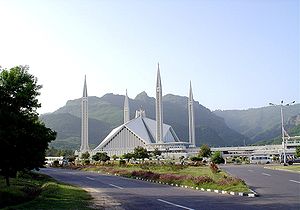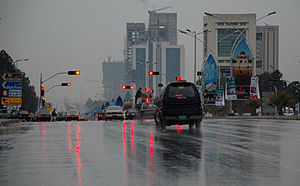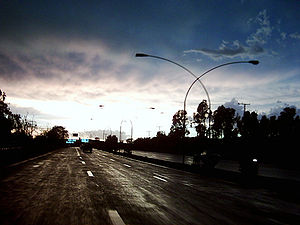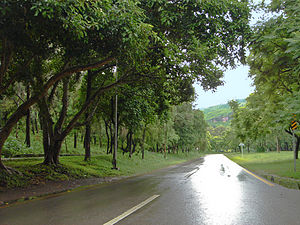- Climate of Islamabad
-
Coordinates: 33°26′N 73°02′E / 33.43°N 73.04°E
The climate of Islamabad has a typical version of humid subtropical climate, with hot summers accompanied by a monsoon season followed by fairly cold winters. The hottest months are May and June, where average highs routinely exceed 38 °C (100.4 °F).The monsoon season is from June to September, with heavy rainfalls and evening thunderstorms with the possibility of cloudburst. Winters are lasted from November to March with temperatures variable by location. In Islamabad, temperatures vary from cold to mild, routinely dropping below zero. In the hills there is sparse snowfall. The weather ranges from a minimum of 3.9 °C (39.0 °F) in January to a maximum of 46.1 °C (115.0 °F) in June.[1] The average low is 2 °C (35.6 °F) in January, while the average high is 40 °C (104.0 °F) in June.[2] The highest temperature recorded was 48 °C (118.4 °F) in June, while the lowest temperature was −4 °C (24.8 °F) in January.[3] On 23 July 2001, Islamabad received a record breaking 620 millimetres (24 in) of rain fell in just 10 hours. It was the heaviest rainfall in 24 hours in Islamabad and at any locality in Pakistan during the past 100 years.[4][5][6]
Climate data for Islamabad (1961–1990) Month Jan Feb Mar Apr May Jun Jul Aug Sep Oct Nov Dec Year Average high °C (°F) 17.1
(62.8)19.1
(66.4)23.9
(75.0)30.1
(86.2)35.3
(95.5)38.7
(101.7)35.0
(95.0)33.4
(92.1)33.5
(92.3)30.9
(87.6)25.4
(77.7)19.7
(67.5)28.5 Average low °C (°F) 2.6
(36.7)5.1
(41.2)9.9
(49.8)15.0
(59.0)19.7
(67.5)23.7
(74.7)24.3
(75.7)23.5
(74.3)20.6
(69.1)13.9
(57.0)7.5
(45.5)3.4
(38.1)14.1 Precipitation mm (inches) 56.1
(2.209)73.5
(2.894)89.8
(3.535)61.8
(2.433)39.2
(1.543)62.2
(2.449)267.0
(10.512)309.9
(12.201)98.2
(3.866)29.3
(1.154)17.8
(0.701)37.3
(1.469)1,142.1
(44.965)Sunshine hours 195.3 189.3 201.5 252.0 313.1 300.0 263.5 251.1 261.0 275.9 249.0 195.3 2,947.0 Source: HKO [7] Contents
Factors
The monsoon and the Western Disturbance are the two main factors that change the weather over Islamabad; otherwise, Continental air prevails for rest of the season. Following are the main factors that influence the weather over Islamabad.
- Western Disturbances occur almost every month in the city, but peaking during the winter months and causes moderate to heavy rainfall, temperature also decreases due to it. These westerly waves are robbed of most of the moisture by the time they reach Islamabad.
- Fog do occur during the winter season and remains for weeks; especially near Margalla Hills.
- Dust storm occur during summer months with peak in May and June. These dust storm are quite violent.
- Southwest Monsoon occurs in summer from the month of June till September. These monsoon rains are quite heavy by nature and can cause severe flooding if they interact with westerly waves.
- Continental air prevails during the period when there is no precipitation in the city.
Monthly weather conditions
The following is the monthly summary of the climatic conditions in Islamabad.
January
January is the coldest month of Islamabad. In January the weather of Islamabad is mild. Rains in this month is heavy like in other season of the city. Typical to Islamabad, there is no snow experienced in the region. Western Disturbance has a great influence in the winter of the city. it produces rains and sometimes hailstorms. The highest temperature is 30.1 °C (86.2 °F) (1995) and lowest temperature is −3.9 °C (25.0 °F) (1967). While the heaviest rainfall for this month is 166.7 millimetres (6.56 in) (1954).
February
The weather of Islamabad in February is similar to that of January. The weather remains mild. Western Disturbance cause rains just like in January. The highest temperature ever recorded was 30 °C (86 °F) (1985) and lowest temperature is −2 °C (28 °F). While the highest rainfall is 268.5 millimetres (10.57 in) (1998).
March
In the month of March the weather starts to settle, In March the weather turns little hot making the weather pleasant. Humidity in this month is about 37%. Again Western Disturbance has an effect on the weather, producing rain and hail. It causes rains with strong winds. Western Disturbance has no timing, it affects the upper and northern parts of Pakistan including Islamabad in every month and season. In this scenario Islamabad gets heavy showers and rains in every month including March. The highest temperature is 34.4 °C (93.9 °F) and the lowest is 0 °C (32 °F). The highest rainfall for March is 224.1 millimetres (8.82 in) (1984).
April
The weather pattern of Islamabad in April is identical to that of March. The weather gets hot in this month, the highest temperature recorded was 40.6 °C (105.1 °F) (2006) and lowest temperature is 5 °C (41 °F) (1994). Humidity remains low in this month about 24%. While the highest rainfall is 264.5 millimetres (10.41 in) (1983).
May
In May the weather gets very hot in the city. The highest temperature is 45 °C (113 °F) (1988) and lowest is 10.0 °C (50.0 °F) (1997). Humidity gets extremely low in May as compared to other month, which is of 19%. Evening thunderstorms can occur in this month accompanied by dust storms that give the citizens of Islamabad much awaited relief from the scorching heat. The highest rainfall is 115.6 millimetres (4.55 in) (1965)
June
June is the hottest month of Islamabad. Temperatures in this month reach till 48 °C (118 °F) as recorded in 2005, While the lowest temperature is 15.7 °C (60.3 °F) (1979). Till the first week of June the weather is identical to May. But in the middle of June Pre-Monsoon showers can start that come from South west Monsoon. Again Western Disturbance too can cause heavy showers, which is not a part of monsoon. Dust storms are common in this month which are locally called as Andhi. The highest rainfall for the month of June is 255 millimetres (10.0 in) (2008). On June 23, 2010, a massive dust storm of 81 mph (130 km/h) hit the city followed by drizzle before the storm, temperatures peaked above 40 °C (104 °F) for four consecutive days.[8]
July
July is the Annual Monsoon season and the wettest month for Islamabad as well as for whole Pakistan that continues till September. In July Islamabad can see some very heavy falls of rain accompanied by Strong Thunderstorms and windstorms. These heavy Storms is due to the moisture coming from Arabian Sea and Bay of Bengal and sometimes if western disturbance interact with them then record rain can be seen. Humidity remains above 65%. The highest temperature in this month is 44.4 °C (111.9 °F) (1987) and lowest temperature is 17 °C (63 °F) (1966) and the highest rainfall for this month is 743.5 millimetres (29.27 in) (1995). The heaviest rain of the city was also recorded in this month when 620 millimetres (24 in) rain occurred in just 10 hours on July 23, 2001 the continuous downpour lasted from 0600 to 1600 PST.[9][4][5][10] In July 2008, a severe rainfall spell, that lasted from 4 to 9 July, produced a heavy rainfall of 162 millimetres (6.4 in) in 5 hours.[11] It was the heaviest short period rainfall in last six years reminding the cloud burst of July 23, 2001. While on July 30, 2010 heavy downpour of 257 millimetres (10.1 in) occurred that caused flash floods in the city.
August
Monsoon rains continue in August as well. The month of August is the most humid month for Islamabad. The highest temperature is 42 °C (108 °F) (1987) and the lowest temperature is 17 °C (63 °F) (1976). While the highest rainfall for this month is 645.5 millimetres (25.41 in) (1982). On August 09, 2011 a cloudburst in Islamabad that continued for three hours and yielded 176 millimetres (6.9 in) of rain, flooded main streets.[12]
September
Monsoon rains continue till the Mid-week of September, after that monsoon completely withdraws from the city. Western disturbance cause showers or little drizzle in this month. The highest temperature is 38.1 °C (100.6 °F) (1982) and lowest is 13 °C (55 °F) (1994). The highest rains in this month is 279.1 millimetres (10.99 in) (1961).
October
October is the driest month in the city. There is drizzle in this month due to westerly wave. The highest rainfall for this month is 95 millimetres (3.7 in) (1997). The highest temperature and lowest temperature is 36 °C (97 °F) (1998)and 5 °C (41 °F) (1984) respectively.
November
The first to second weeks of November is identical to October. But after that Cold winds start to enter the city. Some days of November are hot while other cold. Showers or hailstorms occur in this month too. The highest rainfall for this month is 91 millimetres (3.6 in) (1959) and the highest and lowest temperature is 32 °C (90 °F) (1999) and 0 °C (32 °F) (1970) respectively.
December
In the month is December the winter finally sets in, while the coldest winter of the city is observed in January, weather becomes quite chilly in December too. Western Disturbance cause rain in this month. The highest rainfall for this month is 177.9 millimetres (7.00 in) (1990). The lowest temperature and highest temperature is −2.8 °C (27.0 °F) (1984) and 28 °C (82 °F) (1998) respectively.
Monsoon Rainfall of Islamabad
The average monsoon rainfall of Islamabad is 790.8 millimetres (31.13 in).[13] Monsoon season starts by the end of June and prevails till the end of September. In 2009, Islamabad saw below normal monsoon rainfalls due to the presence of El-Nino over pakistan.[14] It just recorded 354 millimetres (13.9 in) of rain during the Monsoon season in 2009.[13] The highest rainfall of 620 millimetres (24 in) was recorded in Islamabad during 24 hours on 23 July 2001. The record breaking rain fell in just 10 hours. It was the heaviest rainfall in Islamabad in the past 100 years.[15][16] The following is the Monsoon rainfall in Islamabad since 2006 based on the data from Pakistan Meteorological Department.[17]
- In 2006, a total of 962 millimetres (37.9 in) rain was recorded.[17]
- In 2007, a total of 1,117 millimetres (44.0 in) rain was recorded.[17]
- In 2008, a total of 1,108 millimetres (43.6 in) rain was recorded.[18][19][20][21]
- In 2009, a total of 354 millimetres (13.9 in) was recorded.[22][23][24][25]
- In 2010, a total of 1,171 millimetres (46.1 in) was recorded.[26][27][28][29]
- In 2011, a total of 1,716.2 millimetres (67.57 in) was recorded.[30][31]
Cloud Burst of July 23, 2001
On 23 July 2001, Islamabad experienced the record breaking 620 millimetres (24 in) of rainfall, which was the 24 hours heaviest rainfall in Islamabad and at any locality in Pakistan during the past 100 years.[4][5] Continuous downpour in lasted for about 10 hours from 0600-1600 PST in Islamabad,[32][4][5][33] caused the worst ever Flash Flood in the local stream called “Nulla Lai” and its tributaries, which swept away low lying areas of the twin cities. The neighbor city, Rawalpindi also experienced 335 millimetres (13.2 in) of rain on the same day. According to the official figures, at least 10 people died, 800 houses were destroyed and 1069 houses were partially damaged in Islamabad.[34]
Pakistan Meteorological Departments in Islamabad
- National seismic Monitoring and Tsunami Early warning Center, Islamabad (Backup Station)
- Research & Development Islamabad.
- Meteorological Forecasting Offices (mainly for Aviation purposes) Karachi, Islamabad, Lahore.
- Remote sensing, Islamabad,
- Drought, Environmental monitoring & early warning Center Islamabad,
See also
- 2001 Islamabad Cloud Burst
- Climate of Pakistan
- List of extreme weather records in Pakistan
References
- ^ Islamabad (During 1931-2006)
- ^ Country Studies, Climate of Pakistan
- ^ "Average Conditions, Islamabad, Pakistan". http://www.bbc.co.uk/weather/world/city_guides/results.shtml?tt=TT002680. Retrieved 2009-09-25.
- ^ a b c d "Severe Storms on dated 23 July 2001 Islamabad, Pakistan". Abdul Hameed, Director Pakistan Meteorological Department. http://www.essl.org/ECSS/2007/abs/02-Case-study/sheikh-1-sec02.oral.pdf.
- ^ a b c d "Weather Log - July 21–31, 2001". National Climatic Data Center. August 6, 2001. http://www.ncdc.noaa.gov/oa/climate/extremes/2001/july/extremes0701.html.
- ^ http://www.wmo.int/pages/prog/www/DPS/TC-DPFS-2002/Papers-Posters/Topic3-NaeemShah.pdf
- ^ "Climatological Normals of Islamabad". Hong Kong Observatory. http://www.hko.gov.hk/wxinfo/climat/world/eng/asia/westasia/islamabad_e.htm. Retrieved 2011-05-02.
- ^ http://www.geo.tv/6-23-2010/67221.htm
- ^ http://www.meteo.fr/cic/wsn05/resumes_longs/8.02-12.pdf
- ^ http://www.wmo.int/pages/prog/www/DPS/TC-DPFS-2002/Papers-Posters/Topic3-NaeemShah.pdf
- ^ http://www.pakmet.com.pk/rnd/rnd_files/vol6_issue12/4_Case%20Study%20Heavy%20Rainfall%20Event%20over%20Lai%20Nullah%20Catchment%20Area.pdf
- ^ http://awaztoday.com/singlenews/1/11679/Political-News/Rain-wreaks-havoc-in-Islamabad-cities-in-Punjab-and-KP.aspx
- ^ a b http://www.pakmet.com.pk/cdpc/Climate/Islamabad_Climate_Data.txt
- ^ http://www.pakmet.com.pk/monsoon2009ver.pdf
- ^ "Essl.org:Cloudburst in Islamabad" (PDF). Essl.org. http://www.essl.org/ECSS/2007/abs/02-Case-study/sheikh-1-sec02.oral.pdf. Retrieved 6 September 2010.
- ^ "Ncdc.noaa.gov: Climate Extremes". Ncdc.noaa.gov. http://www.ncdc.noaa.gov/oa/climate/extremes/2001/july/extremes0701.html. Retrieved 6 September 2010.
- ^ a b c http://www.pakmet.com.pk/
- ^ http://www.pakmet.com.pk/FFD/index_files/rainjune.htm
- ^ http://www.pakmet.com.pk/FFD/index_files/rainjuly.htm
- ^ http://www.pakmet.com.pk/FFD/index_files/rainaug.htm
- ^ http://www.pakmet.com.pk/FFD/index_files/rainfallsep.htm
- ^ http://www.pakmet.com.pk/FFD/index_files/rainfalljune09.htm
- ^ http://www.pakmet.com.pk/FFD/index_files/rainfalljuly09.htm
- ^ http://www.pakmet.com.pk/FFD/index_files/rainfallaug09.htm
- ^ http://www.pakmet.com.pk/FFD/index_files/rainfallsep09.htm
- ^ http://www.pakmet.com.pk/FFD/index_files/rainfalljune10.htm
- ^ http://www.pakmet.com.pk/FFD/index_files/rainfalljuly10.htm
- ^ http://www.pakmet.com.pk/FFD/index_files/rainfallaug10.htm
- ^ http://www.pakmet.com.pk/FFD/index_files/rainfall.htm
- ^ http://www.pakmet.com.pk/FFD/index_files/rainfall.htm
- ^ http://www.pakmet.com.pk/FFD/index_files/daily/rainfallsep1.htm
- ^ http://www.meteo.fr/cic/wsn05/resumes_longs/8.02-12.pdf
- ^ http://www.wmo.int/pages/prog/www/DPS/TC-DPFS-2002/Papers-Posters/Topic3-NaeemShah.pdf
- ^ http://www.saarc-smrc.org/news-8.html
External links
 Islamabad topics
Islamabad topicsHistory City and Geography Economy and Transport Demographics and Culture Punjabis, Muhajirs, Pashtuns, Islam, Hinduism, Christianity, Politics, Aiwan-e-Sadr, Parliament of Pakistan, Supreme Court of Pakistan, Faisal Mosque, Fatima Jinnah Park, Islamabad Zoo, Golra Sharif, Daman-e-Koh, Pakistan Museum of Natural History, Lok Virsa MuseumSports Islamabad LeopardsCategories:- Islamabad
- Climate by city
Wikimedia Foundation. 2010.





